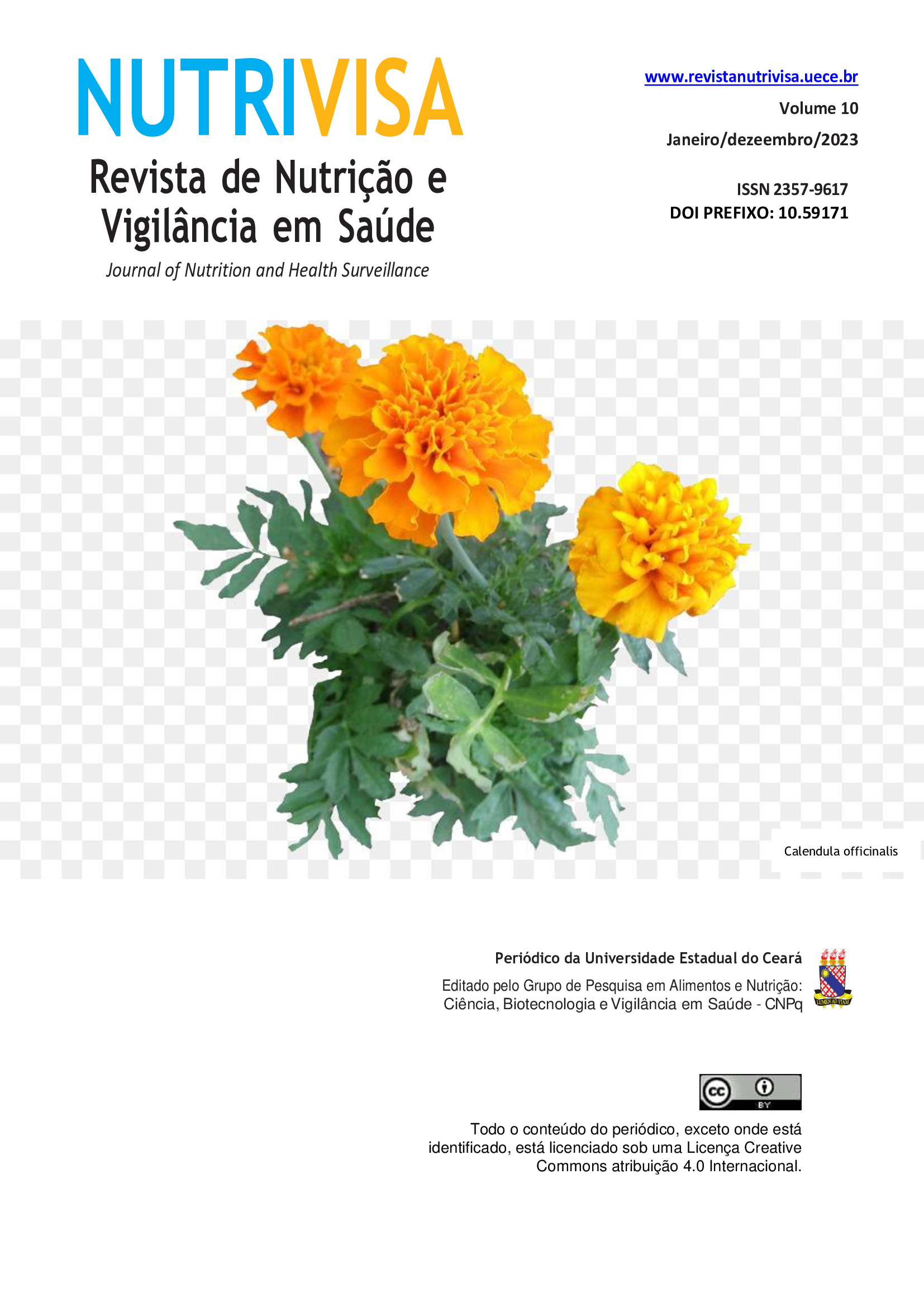Under the shadows of the cashew tree: mocororó of the tremembé, nurturing tradition and harvesting culture
DOI:
https://doi.org/10.59171/nutrivisa-2023v10e10876Keywords:
Fermented beverages, indigenous people, mocororó, Tremembé, cultural identityAbstract
American indigenous peoples use various vegetables to produce fermented foods and beverages, such as corn, cassava, honey, and various fruits. Fermentation preserves and transforms food, benefiting human health. More specifically, in Northeast Brazil, where the cashew tree (Anacardium occidetale L.) is naturally found, mocororó is produced. It is a fermented drink made from cashew apple juice by the indigenous peoples of Ceará. Among the resistance practices that persist among the Tremembé people, this study highlights the fermented beverage of Mocororó and its contribution to the cultural identity of these people. This article aims to discuss cultural identity through a narrative review of the literature, list the importance of knowledge and ways of making Mocororó, and discuss its consumption and anthropological and traditional cultural values. Based on the results found in this study, it is possible to state that Mocororó is a part of the cultural identity of the Tremembé people.
References
ABREU, F.P.; DORNIER, M.; DIONISIO, A.P.; CARAIL, M., CARIS-VEYRAT, C., DHUIQUE-MAYER, C. Cashew apple (Anacardium occidetale L.) extract from by-product of juice processing: A focus on carotenoids, Food Chemistry. v.138, p. 25-31, 2013. doi: https://doi.org/10.1016/j.foodchem.2012.10.028
RAUDEL, F. Civilização material, economia e capitalismo, séculos XV-XVIII. 1ª edição, Martins Fontes, São Paulo, 1995.
CARNEIRO, H. Comida e Sociedade: uma história da alimentação. 1ª edição, Elsevier, Rio de Janeiro. 2003.
CHAUÍ, M. Cultura e democracia. Crítica y emancipación. Revista Latino-Americana de Ciencias Sociales, v. 1, p. 53-76, 2008. http://biblioteca.clacso.edu.ar/ojs/index.php/critica/article/view/195
CORDEIRO, A.M.; OLIVEIRA, G.M.D.; RENTERÍA, J.M.; GUIMARÃES, C. A. Revisão sistemática: uma revisão narrativa. Revista do Colégio Brasileiro de Cirurgiões, v. 34, p. 428-431, 2007.
CASTRO, A.C.R.; VASCONCELOS, L.F.L. Bancos genéticos de Anacardium (caju e cajuí), in: Silva Junior, J.F. da, Souza, F.V.D.; Pádua, J.G. (Eds.), A arca de Noé das frutas nativas brasileiras. Embrapa, Brasília, pp. 63-72, 2021. http://www.alice.cnptia.embrapa.br/alice/handle/doc/1136147
DIMIDI, E.; COX, S.; ROSSI, M.; WHELAN, K. Fermented foods: Definitions and characteristics, impact on the gut microbiota and effects on gastrointestinal health and disease. Nutrients, v.11, p.1806, 2019. doi: https://doi.org/10.3390/nu11081806
GIDDENS, A. Modernidade e identidade. 1ª. edição. J. Zahar, Rio de Janeiro, 2002.
GIL, A.C. Métodos e técnicas de pesquisa social. 6ª edição. Atlas, São Paulo, 2008.
HALL, S. A identidade cultural na pós-modernidade. 1ª edição. DP&A, Rio de Janeiro, 2006.
HALL, S. Da diáspora: Identidades e mediações culturais. 1ª edição, Editora UFMG, Belo Horizonte, 2003.
MARCIANO, A.B.T. O segredo da pedra: projeto editorial de um livro-imagem a partir de aspectos da cultura indígena Tremembé [Trabalho de Conclusão de Curso]. Fortaleza: Universidade Federal do Ceará, 2019. http://www.repositorio.ufc.br/handle/riufc/50830
MONTANARI, M. Comida como cultura. 1ª edição, Editora Senac, São Paulo, 2013.
OLIVEIRA, R.L. O torém como lugar de memória e espaço de formação na educação escolar diferenciada indígena Tremembé [Dissertação de mestrado]. Fortaleza: Universidade Federal do Ceará, 2015. http://www.repositorio.ufc.br/handle/riufc/16650
RODRIGUEZ-AMAYA, D.B.; KIMURA, M.; AMAYA-FARFAN, J. Fontes Brasileiras de Carotenóides: Tabela Brasileira de Composição de Carotenoides em Alimentos, MMA/SPF, Brasília, 2008.
RUTHERFORD, J. Identity: Community, Culture, Difference. Universidade de Michigan: Lawrence & Wishart, 1990.
SAMPIERI, R.H.; COLLADO, C.F.; LUCIO, P.B. Metodologia de Pesquisa. 1ª edição, McGraw, São Paulo, 2006.
ŞANLIER, N.; GÖKCEN, B.B.; SEZGIN, A.C. Health benefits of fermented foods. Critical Review in Food Science and Nutrition, v.59, p.506-527, 2019. doi: https://doi.org/10.1080/10408398.2017.1383355
SANTOS, C.M.; LIMA, A.E.F.; MORAIS, A.C. da S.; FERREIRA, M.C. O mocororó e sua importância para os povos indígenas do litoral cearense – Resistencia e espiritualidade nos modos de fazer e consumir, in Pereira, D., Santo, J.P. do E. (Eds.), Cultura e história dos povos indígenas. Atena, Ponta Grossa, pp. 146-159, 2020.
SILVA, R.S.S.; LIMA, A.E.F.; MORAIS, A.C. da S. Um estudo sobre a bebida indígena mocororó: Aceitação por não indígenas e cultura alimentar do Povo Kanindé de Aratuba, Brazilian Journal of Development, v.6, p.31985-32005, 2020. doi: https://doi.org/10.34117/bjdv6n5-592
VENTURINE FILHO, W.G., 2018. Bebidas alcoólicas: Ciência e Tecnologia. 1ª edição, Blucher, São Paulo, 2018.
Downloads
Published
How to Cite
Issue
Section
License
Copyright (c) 2023 Rafael Amaral, Marina Miranda Ribeiro Gonçalves, Fernando Matias, Adriana Siqueira, Ana Erbênia Mendes, Francisca Elisângela Lima, Paulo Sousa

This work is licensed under a Creative Commons Attribution 4.0 International License.














